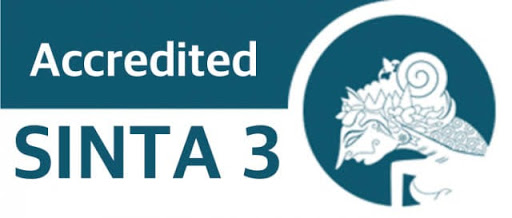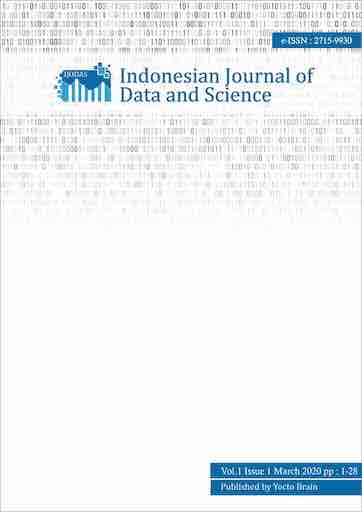Analisis Performa Algoritma Stochastic Gradient Descent (SGD) Dalam Mengklasifikasi Tahu Berformalin
Abstract
Tahu berformalin adalah salah satu jenis makanan yang sering mengandung bahan-bahan kimia yang dapat mengawetkan daripada tahu tanpa formalin. Pada tahu berformalin dapat memberikan tekstur lebih kenyal dan berwarna putih bersih. Penelitian ini bertujuan untuk mengklasifikasikan tahu berformalin dan tahu tidak berformalin. Pada paper ini menggunakan algoritma Stochastic Gradient Descent atau dalam penerapannya lebih dikenal dengan SGD Classifier yang merupakan bagian dari algoritma machine learning untuk klasifikasi, regresi maupun jaringan syaraf tiruan serta algoritma ini sangat efisien pada dataset berskala besar. Penelitian ini mencoba menerapkan algoritma SGD pada dataset tahu berformalin dengan jumlah dataset yakni 11000 yang dimana 5500 data tahu berformalin dan 5500 data tahu tidak berformalin. Setelah dilakukan beberapa tahapan dalam pengujian dengan algoritma SGD maka diperolah hasil akurasi, presisi, recall, f1-score pada model yang masing-masing 82.6% untuk akurasi, 81.7% untuk presisi, 84.1% untuk recall, 83.5% untuk f1-score dan dilakukan pengujian menggunakan 10 data yang tidak termasuk dalam data latih memperoleh performansi rata-rata akurasi sebesar 70%, presisi 71%, recall 70% dan f1-score 70%.
Downloads
References
W. Astuti, D. Lenono, and F. Faizah, “Identifikasi Tahu Berformalin dengan Electronic Nose Menggunakan Jaringan Syaraf Tiruan Backpropagation,” IJEIS (Indonesian J. Electron. Instrum. Syst., vol. 6, no. 2, p. 211, 2016, doi: 10.22146/ijeis.15330.
S. Mezzatesta, C. Torino, P. De Meo, G. Fiumara, and A. Vilasi, “A machine learning-based approach for predicting the outbreak of cardiovascular diseases in patients on dialysis,” Comput. Methods Programs Biomed., vol. 177, pp. 9–15, 2019, doi: 10.1016/j.
S. Zahara and S. Sugianto, “Prediksi Indeks Harga Konsumen Komoditas Makanan Berbasis Cloud Computing Menggunakan Multilayer Perceptron,” JOINTECS (Journal Inf. Technol. Comput. Sci., vol. 6, no. 1, p. 21, 2021, doi: 10.31328/jointecs.v6i1.1702.
Herman et al., “Comparison of Artificial Neural Network and Gaussian Naïve Bayes in Recognition of Hand-Writing Number,” Proc. - 2nd East Indones. Conf. Comput. Inf. Technol. Internet Things Ind. EIConCIT 2018, no. 1, pp. 276–279, 2018, doi: 10.1109/EICon
H. Zhang, “The optimality of Naive Bayes,” Proc. Seventeenth Int. Florida Artif. Intell. Res. Soc. Conf. FLAIRS 2004, vol. 2, pp. 562–567, 2004.
T. F. Wu, C. J. Lin, and R. C. Weng, “Probability estimates for multi-class classification by pairwise coupling,” J. Mach. Learn. Res., vol. 5, pp. 975–1005, 2004.
C. A. U. Hassan, M. S. Khan, and M. A. Shah, “Comparison of Machine Learning Algorithms in Data classification,” Int. Conf. Autom. Comput., 2018.
J. D. Kelleher, B. Mac Namee, and A. D. Arcy, Fundamentals of Machine Learning For Predictive Data Analytics Algorithms, Worked Examples, and Case Studies. London: The MIT Press, 2015.
A. Maulida, “Penerapan Metode Klasifikasi K-Nearest Neigbor pada Dataset Penderita Penyakit Diabetes,” Indones. J. Data Sci., vol. 1, no. 2, pp. 29–33, 2020.
H. Azis, F. T. Admojo, and E. Susanti, “Analisis Perbandingan Performa Metode Klasifikasi pada Dataset Multiclass Citra Busur Panah,” Techno.Com, vol. 19, no. 3, 2020.
S. Sahar, “Analisis Perbandingan Metode K-Nearest Neighbor dan Naïve Bayes Clasiffier Pada Dataset Penyakit Jantung,” Indones. J. Data Sci., vol. 1, no. 3, pp. 79–86, 2020, doi: 10.33096/ijodas.v1i3.20.
Hasran, “Klasifikasi Penyakit Jantung Menggunakan Metode K-Nearest Neighbor,” Indones. J. Data Sci., vol. 1, no. 1, pp. 1–4, 2020.
W. Purnami, A. M. Regresi, and L. Ordinal, “Perbandingan Klasifikasi Tingkat Keganasan Breast Cancer Dengan Menggunakan Regresi Logistik Ordinal Dan Support Vector Machine ( SVM ),” J. Sains Dan Seni Its, vol. 1, no. 1, 2012.
Nirmalasari, “Analisis Performa Metode Naïve Bayes Classifier Dan Cross Validation Pada Data Penyakit Cardiovascular,” Indones. J. data Sci., 2020.
Y. Nataliani, S. M. Tambunan, and E. S. Lestari, “Perbandingan Klasifikasi dengan Pendekatan Pembelajaran Mesin untuk Mengidentifikasi Tweet Hoaks di Media Sosial Twitter,” JEPIN (Jurnal Edukasi dan …, vol. 7, no. 2, pp. 112–120, 2021.
R. Dwiyansaputra, G. S. Nugraha, F. Bimantoro, and A. Aranta, “Deteksi Sms Spam Berbahasa Indonesia Menggunakan Tf-Idf Dan Stochastic Gradient Descent Classifier ( Indonesian Sms Spam Detection Using Tf-Idf And Stochastic Gradient Descent,” J. Teknol. Inf
M. M. Baharuddin, T. Hasanuddin, and H. Azis, “Analisis Performa Metode K-Nearest Neighbor untuk Identifikasi Jenis Kaca,” Ilk. J. Ilm., vol. 11, no. 28, pp. 269–274, 2019.
A. Fitria and H. Azis, “Analisis Kinerja Sistem Klasifikasi Skripsi menggunakan Metode Naïve Bayes Classifier,” Pros. Semin. Nas. Ilmu Komput. dan Teknol. Inf., vol. 3, no. 2, pp. 102–106, 2018.
L. Nurhayati and H. Azis, “Perancangan Sistem Pendukung Keputusan Untuk Proses Kenaikan Jabatan Struktural Pada Biro Kepegawaian,” Semin. Nas. Teknol. Inf. dan Multimed., pp. 6–7, 2016.
D. Cahyanti, A. Rahmayani, and S. Ainy, “Analisis performa metode Knn pada Dataset pasien pengidap Kanker Payudara,” Indones. J. Data Sci., vol. 1, no. 2, pp. 39–43, 2020.
D. D. Novita, A. B. Sesunan, M. Telaumbanua, S. Triyono, and T. W. Saputra, “Identifikasi Jenis Kopi Menggunakan Sensor E-Nose Dengan Metode Pembelajaran Jaringan Syaraf Tiruan Backpropagation,” J. Ilm. Rekayasa Pertan. dan Biosist., vol. 9, no. 2, pp. 20

Authors retain copyright and full publishing rights to their articles. Upon acceptance, authors grant Indonesian Journal of Data and Science a non-exclusive license to publish the work and to identify itself as the original publisher.
Self-archiving. Authors may deposit the submitted version, accepted manuscript, and version of record in institutional or subject repositories, with citation to the published article and a link to the version of record on the journal website.
Commercial permissions. Uses intended for commercial advantage or monetary compensation are not permitted under CC BY-NC 4.0. For permissions, contact the editorial office at [editorial email/contact form].
Legacy notice. Some earlier PDFs may display “Copyright © [Journal Name]” or only a CC BY-NC logo without the full license text. For the avoidance of doubt, authors hold copyright, and all articles are distributed under CC BY-NC 4.0. Where any discrepancy exists, this policy and the article landing-page license statement prevail.














